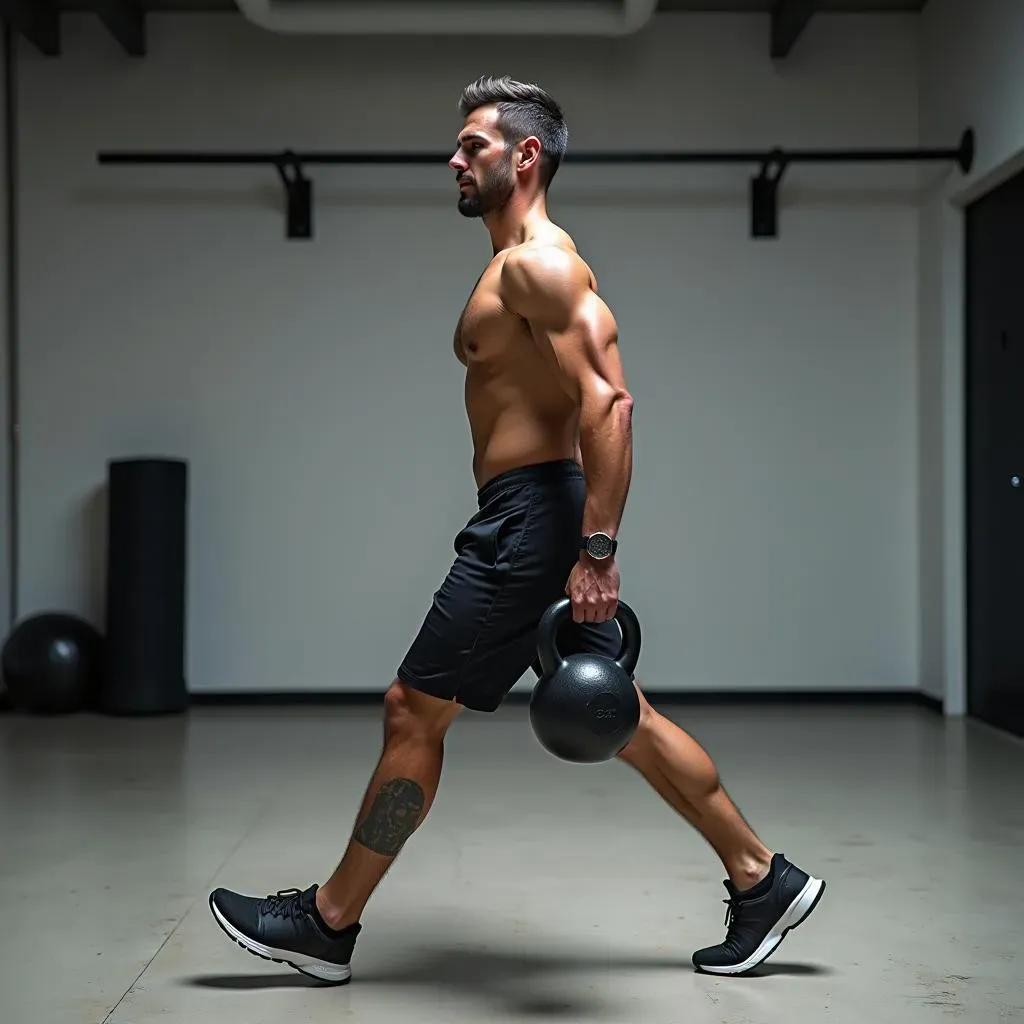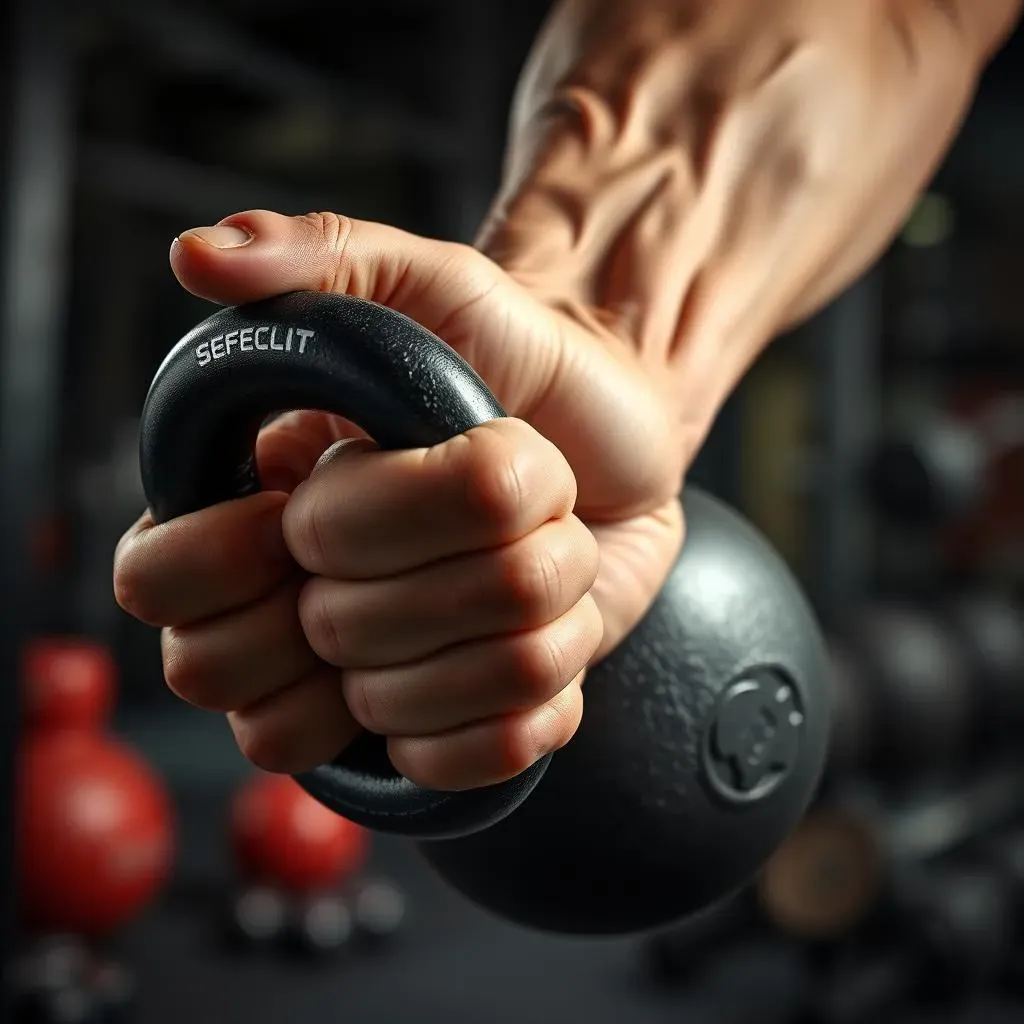Table of Contents
Tired of endless crunches that leave you feeling more bored than sculpted? I get it. There's a better way to build a core of steel, and it doesn't involve lying on the floor. Forget those sit-ups, because we're about to unlock the power of kettlebell core exercises standing. This isn't just about getting a six-pack; it's about building functional strength, improving your posture, and feeling like a total badass. This article will guide you through five killer standing kettlebell exercises that will target your abs, obliques, and those tricky stabilizer muscles you didn't even know you had. We'll break down each move, explain why it works, and even give you a sample workout to get you started. Get ready to ditch the floor and discover how to strengthen your core while standing tall. Let's get to it!
Why Standing Kettlebell Core Exercises?

Why Standing Kettlebell Core Exercises?
Beyond the Crunch: Functional Strength
Let's be real, how often do you crunch in real life? Probably never, right? That's why standing kettlebell core exercises are such a game-changer. They mimic movements you actually do every day, like walking, lifting, and twisting. This means you're not just building a pretty six-pack; you're creating a core that's ready for anything life throws at you. Think about carrying groceries, picking up your kid, or even just reaching for something on a high shelf. A strong, functional core makes it all easier and safer. It's about real-world strength, not just gym aesthetics.
I remember one time, I was helping a friend move, and he was struggling to lift a box. I, on the other hand, had been doing a lot of kettlebell work and was able to lift that same box with ease. That's when it hit me, this isn't just for looking good, it's for real life.
Engaging More Than Just Your Abs
When you're doing a plank or a sit-up, you're mostly isolating your abs, and that's fine but it's not the whole story. Standing kettlebell exercises are different. They force your entire body to work together as a unit. You're engaging your back, your legs, your shoulders, and even your grip. This means you're burning more calories, building more overall strength, and improving your balance and coordination. It is a full-body party, and your core is the DJ. These moves are less about isolating specific muscles and more about creating a strong and stable foundation for all your movements. Think of it as building a powerhouse, not just a single muscle.
Exercise Type | Muscles Primarily Targeted | Additional Muscles Engaged |
|---|---|---|
Traditional Crunches | Rectus Abdominis (Abs) | Minimal |
Standing Kettlebell Exercises | Abs, Obliques, Transverse Abdominis | Back, Legs, Shoulders, Grip |
The Stability Advantage
One of the biggest benefits of standing core work is the challenge to your stability. When you're standing, your body has to work much harder to maintain balance, which means your core muscles are constantly firing to keep you upright and steady. This is a huge advantage over lying down, where gravity is doing most of the stabilizing for you. Think about it, if you’re on your feet all day, why not train your core to be strong and stable while you're standing? It's like giving your body a constant workout, even when you're not actively exercising.
This type of training translates directly into better balance and coordination in your everyday life, making you more agile and less prone to injury. It's not just about strength; it's about control and stability. And let's be honest, who doesn't want to feel more grounded and powerful?
Top 5 Standing Kettlebell Core Exercises

Top 5 Standing Kettlebell Core Exercises
Kettlebell Suitcase Marches: More Than Just a Walk
don't let the name fool you; this isn't your grandma's stroll. The kettlebell suitcase march is a deceptively challenging exercise that targets your core stability big time. You'll hold a kettlebell in one hand, like you're carrying a heavy suitcase, and then march in place, focusing on keeping your body upright and your core tight. It's that simple, yet so effective. This move forces your core to resist rotation and lateral flexion, making it a fantastic anti-rotation exercise. Think of your core as the anti-sway bar in a car, keeping you stable and balanced.
I remember the first time I tried these; I thought, "This is easy," but after just a few reps, my core was screaming! It's amazing how such a simple movement can work so many muscles at once. It’s a real testament to the power of functional training.
Kettlebell Halos: A Circle of Strength
Next up, we have kettlebell halos. These are like a gentle dance for your core and shoulders. You'll hold a kettlebell by the horns (the sides of the handle) and circle it around your head, keeping your core engaged and your back straight. This move works your core from all angles, while also improving your shoulder mobility and stability. It might look easy, but it’s a great way to challenge your core and improve your overall coordination. Think of it as a moving plank, where your core has to work hard to keep your body stable as you move the weight around your head.
I find this exercise particularly helpful for warming up my shoulder muscles before a heavy workout. It's a great way to get the blood flowing and prepare your body for more intense movements.
Exercise | Primary Core Focus | Secondary Benefits |
|---|---|---|
Suitcase Marches | Anti-rotation, Lateral Stability | Leg Strength, Balance |
Halos | Overall Core Stability | Shoulder Mobility, Coordination |
Kettlebell Windmills: A Twist on Core Strength
Now, let's talk about kettlebell windmills. This move is a bit more complex, but it's worth the effort. You'll stand with your feet wider than shoulder-width apart, holding a kettlebell overhead, and then hinge at your hips, reaching towards the ground with your free hand while keeping the kettlebell arm straight up. This exercise works your obliques, your core, your hamstrings, and your shoulders all at once. It's like a full-body stretch with a strength component. It is a great exercise to improve your flexibility, mobility, and core stability. It's a total package deal, and I love it.
I’ll admit, I struggled with this one at first. It felt awkward, but after some practice, I started to get the hang of it. Now, it's one of my go-to exercises for a strong and stable core. It's a reminder that sometimes the most challenging exercises are the most rewarding.
Standing Kettlebell Core Workout: EMOM Style

Standing Kettlebell Core Workout: EMOM Style
What's the EMOM Buzz?
so you've got the exercises down, but how do you put them all together? That's where the EMOM (Every Minute On the Minute) protocol comes in. It is simple, yet incredibly effective. You'll start each exercise at the beginning of a minute, perform the specified number of reps, and then use the remaining time to rest before moving on to the next exercise. For example, if it takes you 30 seconds to do your set of suitcase marches, you get 30 seconds to chill before the next minute starts. It's a great way to keep the workout structured, while also allowing for some flexibility based on your fitness level. It's like having a personal trainer yelling at you, but in a good way.
This method is perfect for keeping you accountable and pushing you just enough, while it also allows for recovery. It also keeps your heart rate up, making it a great option for those who want to burn some extra calories while they build their core strength. I've found it to be a really fun way to train, and it's helped me stay consistent with my workouts. It's a game-changer.
The Workout Blueprint
Alright, let's break down the workout. We'll be doing three rounds of five exercises, using the EMOM format I just talked about. The exercises are: Suitcase Marches, Halos, Windmills, Hand-to-Hand Passes, and Openers. This combination will hit your core from every angle, ensuring you're building a truly strong and functional midsection. Remember, it's not about speed; it's about control and proper form. Take your time, and focus on engaging your core throughout each movement. It's much better to do a few reps correctly than a bunch of reps with bad form. Quality over quantity, always.
Here's the breakdown of the workout:
- Minute 1: 30 Kettlebell Suitcase Marches (15 per side)
- Minute 2: 10-12 Kettlebell Halos
- Minute 3: 6-8 Kettlebell Windmills (3-4 per side)
- Minute 4: 20 Kettlebell Hand-to-Hand Passes
- Minute 5: 8-10 Kettlebell Openers
Tips for Success
First, remember to choose a kettlebell weight that’s challenging but manageable. You should be able to complete all the reps with good form, but feel like you’re working. If you’re new to kettlebells, start with a lighter weight and gradually increase it as you get stronger. Also, don't forget to breathe. I know it sounds silly, but holding your breath can actually hinder your performance and make the exercise harder than it needs to be. Inhale during the less strenuous part of the movement, and exhale during the more strenuous part. It's like giving your muscles a little boost of energy. Finally, listen to your body. If you’re feeling pain, stop the exercise and rest. It’s better to take a break than to push through and risk injury. Be smart, be safe, and have fun!
Mastering the Kettlebell: Tips and Tricks for Core Work

Mastering the Kettlebell: Tips and Tricks for Core Work
Grip It Right: Your Foundation for Success
let's talk grip, because it's a game-changer. A lot of people just grab a kettlebell any old way, but that's a recipe for disaster. You want a firm, but not death-grip, on the handle. Imagine you're shaking someone's hand – firm, but not crushing their bones. This helps you maintain control of the weight and prevents it from wobbling all over the place. It's also going to help you connect to the muscles in your core and back and that connection is where the real magic happens. Think of your grip as the steering wheel of your core workout, guiding the movement and making it more effective. A proper grip will allow you to engage the right muscles and prevent injury. It's not just about holding on, it's about engaging your whole arm and upper back.
I’ve seen so many people struggle with kettlebells simply because their grip is off. They lose control of the weight, their form falls apart, and they end up just flailing around. Take a moment to make sure your grip is solid and you’ll see a huge difference in your performance. It’s like putting on the right pair of shoes before a run. It might seem small, but it makes all the difference in the world.
Form Over Everything: Quality Reps Matter
I can't stress this enough: form over everything! Forget about trying to lift the heaviest kettlebell in the gym if your form is trash. It's not a competition, it's about building strength safely and effectively. Focus on slow, controlled movements, and make sure you are engaging your core throughout the entire exercise. If you start to feel your back taking over, it’s a sign that you need to lighten the weight or take a break. Remember, the goal is to work your core, not your lower back. Your core is like the conductor of an orchestra, and all your other muscles are the instruments. If the conductor isn't doing their job properly, the music will sound terrible. So focus on form, and let your core do its thing.
I used to be so focused on lifting heavy that I completely neglected my form. I ended up with a sore back and zero core strength. It wasn’t until I slowed down and focused on quality over quantity that I started to see real results. It's not about how much you can lift, it's about how well you can lift. It’s a mindset shift, for sure, but it’s the most important change you can make in your training.
Tip | Description |
|---|---|
Grip | Firm, but not crushing. Imagine shaking a hand. |
Form | Slow, controlled movements. Focus on core engagement. |
Weight | Start light, gradually increase as you get stronger. |
Breathing | Inhale on less strenuous part, exhale on more strenuous part. |
Listen to Your Body: It's Your Best Coach
Your body is a smart cookie, and it will tell you when something is off. If you feel a sharp pain, stop the exercise immediately. It's okay to take breaks, to reduce the weight, or to modify the exercise if needed. Pushing through pain is never a good idea, and it's a surefire way to end up injured and sidelined. It is better to do a modified version of an exercise with good form than it is to do the full exercise with bad form. There's no shame in modifying a move to fit your needs. You are the best judge of what your body can handle, so listen to those signals.
I’ve learned the hard way that ignoring pain is never worth it. I once tried to push through a workout when I had a twinge in my shoulder, and I ended up being out of commission for weeks. Now, I’m much more careful and I pay attention to what my body is telling me. It’s like having a conversation with your muscles. They’ll tell you when they need a break, and if you listen, you’ll be able to train smarter and avoid injuries. It’s all about being in tune with your body.
Progressive Overload: The Key to Growth
Once you’ve mastered the basics, it’s time to start thinking about progressive overload. This basically means gradually increasing the challenge to your muscles over time, whether it's by adding weight, increasing reps, or decreasing rest time. This is how your body adapts and gets stronger. If you keep doing the same workout day after day, your progress will eventually stall. You have to keep challenging your body to see results. Think of it as leveling up in a video game. You wouldn’t stay on the first level forever, would you? You’d want to move on to more challenging levels, and that’s exactly what you need to do with your workouts. Progressive overload is not about being reckless; it’s about being smart and strategic with your training.
I've found that keeping a workout log is a great way to track my progress and make sure I'm consistently challenging myself. It's also super motivating to look back and see how far I've come. It’s like having a personal journal of your fitness journey, and it's a great way to stay on track and keep pushing yourself towards your goals. Remember, consistency is key, but so is making sure you're always pushing your limits in a safe and effective way. It's a journey, not a sprint.
Standing Tall, Core Strong
So, there you have it – a whole new way to think about core work. No more endless crunches; instead, you have five powerful kettlebell core exercises standing ready to transform your midsection. These aren't just about aesthetics either. They're about building real, functional strength that you can use in your everyday life, whether you're lifting groceries or dominating your next workout. Remember, consistency is key, and proper form trumps heavy weight. So, grab your kettlebell, stand tall, and get ready to unlock a core that's as strong as it is impressive. You got this!